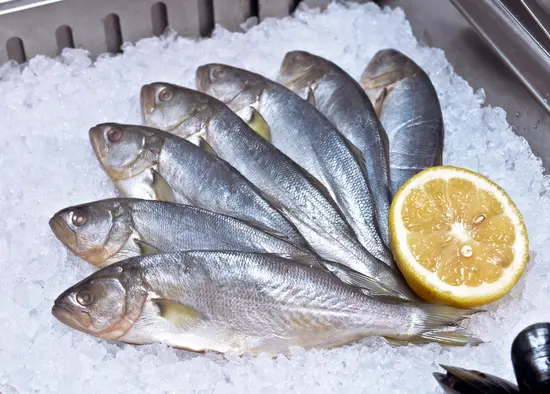Bluefish have legendary reputations as strong and powerful inshore sportfish, but their reputation as table fare leaves much to be desired. Some people say that they are too fishy, smelly, and oily to even try to eat.
In this article, I’ll teach you how to make bluefish taste good to even the pickiest eaters!
Table of Contents
- What Does Bluefish Taste Like?
- How To Prepare Bluefish
- Use Milk To Make Bluefish Taste Good
- Citrus Is Great With Bluefish
- Smoking Can Make Delicious Bluefish
- Vinegar Can Help Prepare Bluefish
- Conclusion
What Does Bluefish Taste Like?
Bluefish meat is very dark compared to most fish. Dark meat fish generally have a higher oil content and a fishier flavor than fish with white flesh. When prepared well, bluefish is similar to Spanish mackerel or albacore.

This is due to more blood being present in the meat of the fish, as well as other factors, such as diet and muscle content.
When prepared poorly, this often leads to soft, mushy fillets that have an overwhelming flavor of fish oil.
It’s easy to see how this experience could turn someone away from ever eating bluefish again. But is there any way to get over Bluefish’ reputation of having a bad taste?
If you take a few extra steps, however, you can have a fish that’s on par with many other popular food fish. This will leave you with a much milder flavor with a slightly sweet and tangy undertone with only the slightest hint of oiliness.
How To Prepare Bluefish
This is what you should do between catching your bluefish and starting the cooking process. It is the most crucial point in ensuring that your bluefish is palatable.
The first step in making bluefish delicious is to choose the right ones to eat. Larger fish tend to build up more of that fishy flavor. I would recommend only keeping the ones under 18 inches, but really 12-15 inches is the sweet spot.
Before you put your fish in the cooler, you will want to bleed it. Most of the fishy flavor is stored in the blood of a fish.
Make a few cuts through the gills and position your fish so its head is facing downward to allow all of the blood to drain out and take the fishiness with it.
Once your fish has been bled, remove it from the blood and place it in a cooler with ice and saltwater.
The saltwater keeps the texture of the meat intact by preventing salts from diffusing out. The sooner you get your bluefish in a cooler, the fresher it will taste.
If you can, gut or fillet your fish immediately after catching it. The guts can leach unpleasant flavors into the meat, so separating them from the rest of the fish as soon as possible makes it taste the freshest.
When filleting your bluefish, you will notice a red streak down the middle of each fillet.
This is called the bloodline and is a section of dark, oily muscle. Bleeding the fish reduces the size of the bloodline, but you should still cut this section out to vastly reduce the fishiness of the fillet.
Use Milk To Make Bluefish Taste Good
Soaking bluefish in milk or buttermilk is a great way to remove most of the fishy flavor. Since the fishiness is stored in the oil of a fish it is fat soluble. Soaking it in milk dissolves much of the flavor in the fat particles of the milk.
This method is my personal favorite and one of the most common techniques for freshening up bluefish. It is great because it doesn’t add any flavor to the meat so it can be paired with any style of cooking.
To do this, simply fillet your bluefish and place the fillets in a bag with milk for at least 30 minutes, up to overnight. You will be left with a mild-tasting fillet and some very fishy milk.
Related: How To Catch Bluefish From Shore (What To Look For & Tips.)
Citrus Is Great With Bluefish
The acids in citrus juice are excellent for breaking down and masking the fishy smell within a bluefish’s meat and as a bonus, they are a great flavor to pair with any bluefish dish.
Lemon, lime, and orange juice all make great marinades for bluefish.
Place your fillets in a bath of citrus juice for 30 minutes to 2 hours depending on your flavor preferences. You can add any combination of herbs and spices to this marinade to accompany the citrus flavor.
Eating With The Ecosystem has a great example recipe with Bluefish and citrus.
Additionally, you can squeeze a fresh lemon or lime over your cooked bluefish for a fresh kick that brightens the flavor of the dish.
Smoking Can Make Delicious Bluefish

Smoking bluefish masks its oily flavor while complimenting the other flavors in the fish. The drying process that takes place while smoking also mellows the fishiness of the meat.
To smoke your bluefish, start putting it in brine with flavors of your choice. Keep in mind that more acidic flavors will further reduce fishiness in the meat.
Smoke your bluefish at 225-250 degrees Fahrenheit for 1.5 to 2 hours, then lower the temperature to 170 degrees and smoke for another 1.5 to 2 hours.
Woods with a strong flavor such as hickory or walnut are best for bluefish as they mask the fishy flavor.
Many people prefer to put their smoked fish in a dip. Just shred it, add to cream cheese and sour cream, and combine it with your favorite spices. I recommend chives, paprika, garlic, lemon, and cumin.
See also: The 12 Best Bluefish Lures (& How To Fish Them!)
Vinegar Can Help Prepare Bluefish
Vinegar is very acidic and much like lemon and lime juice, it can be used to neutralize the oils within bluefish meat.
Personally, I would prefer to eat fishy fish over vinegar-flavored fish, but if you can’t stand the taste of bluefish and are partial to the bitterness that vinegar provides, this is a super effective way to flush out the fishy flavor.
Just place your fillets in a pan and pour white or balsamic vinegar over them. Allow them to sit for around 30 minutes. Don’t let your fish sit in the vinegar for too long, or the acids will turn your raw fish into ceviche.
Conclusion
While bluefish can’t compare to any tuna or snapper, they certainly can be delicious. Try one or more of these methods next time you catch a bluefish before writing them off as inedible.

Growing up in Florida, I’ve been surrounded by saltwater my entire life…and I love sharing my passion with others.
To learn more about why I started Saltwater Mecca, visit the ABOUT page.
Thank you for reading this article. Browse around & have some fun!